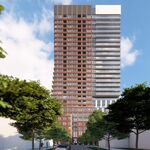I am still digesting the curve data that
@Urban Sky provided, and trying to assemble and end to end speed model for Toronto-Ottawa. While I don't have a final end to end calculations, I thought I would test my assumptions before I sink any further into Excell. There are some interesting high level realities that have struck me without a precise assessment of the actual track plan.
The starting point is the assumption that VIA's Siemens equipment will be the benchmark equipment for this run.
My first key assumption is that its performance envelope will prove to be similar to the "InterCity" equipment cited in
@Urban Sky's thesis. The important point is the acceleration/deceleration parameter - 0.37m/sec^2. I am using that statistic for all my calculations of acceleration and deceleration on the line. That number may not be reality, but it's a sensible figure to use, and it aligns to
@Urban Sky's work.
Second, I am assuming that deceleration and acceleration rates should be treated as the same.... again, that may not be the case, but it's a conservative assumption for modelling.
Finally, I am assuming that the superelevation that VIA can achieve on curves is, as noted in above posts, 8 inches total - three unbalanced and five balanced. While there is freight traffic west of Havelock, let's assume its volume is not so great to force lower superelevation. Using
this FRA chart, the good news is, I can assume that a 3 degree curve can be negotiated at 60 mph. (I am doing all my work in miles rather than kilometers, so as to align to railway mileposts....it just keeps the source data readable). Since 3 degree curves are the most problemmatic limiting curve, 60 mph becomes the "worst case" for speed, other than in a few sections where either curvature is extraordinary or speed may be restricted for other reasons eg in urban areas.
The interesting thing for this track scenario is - we have numerous 3 degree curves where speed will have to be 60 mph, separated by shortish sections of tangent. In theory, one ought to model trains as running at the 3 degree maximum (60 mph) through the curves, then accelerating when possible, and slowing down for the next curve.
Conclusion #1: The sheer number of these curves forces one to look at the line as a "60 mph line with the opportunity to go faster in places" rather than a "110 mph line with some slow sections". That's not all bad news, considering that highway speeds are comparable, and the 60 mph prevailing speed is a lot better than I had feared (I had figured most curves would be in the 50 mph range). So end to end times may prove to be fairly competitive to bus or car. (EDIT: This is most true east of Tweed; west of there there are certainly some credible 110 mph capable segments)
Here's the rub: Using the 0.37m/sec^2 spec, converted to mph of course, it takes a longer stretch of tangent to apply this principle than the actual track allows. I produced a table showing the distance needed for a train to accelerate from one speed to another speed.
View attachment 271638
For the most favourable scenario - ie a train having slowed to 60 mph, then sprinting back up to 110 mph, it will take 1.42 miles to get back to 110 mph. If another slow section is approaching, it will take a further 1.42 miles to slow from 110 mph back down to 60 mph.
Conclusion #2: Because the tangent sections between curves are rarely a minimum of 2.84 miles long, in many places the usable speed of tangent track will frequently not be 110 mph.
The practical problem this creates is that, in the absence of a sophisticated autopilot, a train run by human hand will have difficulty handling all the changes in speed to extract the optimum speed-up/slow-down cycles required. Further, the number of full throttle-followed-by-heavy-braking cycles are not condusive to equipment SOGR or fuel efficiency. The likely solution will be to impose "zone" speeds which limit speed over the short tangent stretches to something close to or equal to the slow points of the curves.
How much does this affect the speed envelope? Here's a hypothetical example. Consider a three mile tangent section between two 60 mph curve sections. One would like the train to accelerate in between, but here's how that looks:
View attachment 271639
Now consider the alternative - just declare the whole length of track, ie the two curves, and the tangent connecting them, as one "zone" limited to 60 mph. The "No Accel" scenario shows the time required, compared to the speed-up-then-brake scenario. The "zone" scenario adds an extra minute to the timing over the "go like stink" scenario. Again, the sheer number of these short tangent sections suggests that a great deal of tangent track will not be usable at the vision of 110 mph. That will add minutes to the timing.
One reads many anecdotal accounts of how fast trains ran in the steam era, where locomotives didn't necessarily have a speedomenter, and speed enforcement was minimal. Old-school engineers did often work from the "go like stink" premise. However, I doubt that it would pass either today's regulatory regime, or a value engineering analysis.
I thought I would put this out there before I try to guesstimate where "zone" performance will be reality. It's a good news, bad news picture. While I haven't concluded that the line is a dud, I would discourage those who imagine it as a 110 mph racetrack.
Please, critique the above to shreds..... I'm still working on the granular picture, better now before I have to rework stuff.
- Paul




